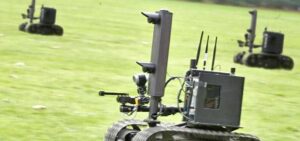While the U.S. military is laser focused on day-to-day operations, it always has an eye on the future. More specifically, on how to encourage innovation and leverage technologies, products and approaches that can better ensure mission success.

This past spring I had the pleasure of speaking at the Mad Scientist Conference on Robotics, Artificial Intelligence and Autonomy. The event brought together a fascinating mix of presenters from academia, research organizations, and Army R&D centers, all speaking about how artificial intelligence, autonomous systems and robotics will change warfare.
My presentation in many ways outlined SRI’s vision for the future, and was also the product of SRI’s work on the Roadmap for US Robotics – From Internet to Robotics 2016 Edition. Some of the areas I highlighted, such as autonomy and AI, are outlined below.
Goal oriented, adaptive, trusted and distributed autonomy
At SRI, we are focused on shifting robotics from reactive, minimal human control, point solutions and single platform autonomy to goal oriented, adaptive, trusted and distributed autonomy. This approach embodies several capabilities, including precise multi-modal sensing, goal-oriented autonomy, trusted collaboration, ethics and morality, distributed autonomy, continuous learning and flexible task embodiment.
Take the case of flexible task embodiment: Today most industrial robotics systems are fixed and built to execute one task, such as welding, and are not utilized for other applications. The technology is now mature enough to, in effect, take robots out of the cage and execute a combination of human-led and robot-led interactions in a safe and efficient manner using open dialog (speech, gesture, gaze). It also can involve complex mixed-initiative tasks, human-friendly socially assistive robotics (robotics capable of assisting users through social rather than physical interaction) and dexterous manipulation with high precision.
Trusted human-machine collaboration
Trust is a critical element of robotics. Trusted human-machine collaboration will allow us to take robots “out of the cage” so that people can collaborate with them in efficient and safe manner. SRI is exploring algorithms so that humans can trust robots in various forms and use cases. Think autonomous vehicles and what it will take for humans to sit down in the seat and trust the vehicle to safely get us from point A to point B.
For the military, it’s about how can robotics be integrated into human teams in a way that human-machine trust can mirror the trust soldiers build between one another? Today you see robotics units handling mission critical functions such as IED and bomb disposal, but they are still not integrated with the unit for military exercises.
Continuous learning
A key part of human-robot collaboration will involve lifelong machine learning, where humans and robots collaborate to enable machines to identify knowledge gaps, and providing a way for knowledge to be transferred machine to machine, human to machine and machine to human.
For example, great progress has been made in teaching and training machines to beat humans in chess, but to date knowledge of how to beat the world’s best chess players is not transferable. Or how can we take knowledge from a robot performing one action and have that robot or others use that knowledge to perform a different action (i.e. – having computer systems learn over time)?
Another aspect of continuous learning is “learning to learn” by exploiting opportunities to learn based on self-awareness of current limitations. If a team of robots is tasked to clean an office, they must account for different items to clean, move and maneuver around. Not every robot is built to do all of these things, some cleaning requires dexterous manipulation, some require advanced mobility, etc. Continuous learning ensures that each robot understands its strengths and limitations, and through continuous learning the team of robots can work together efficiently to perform all cleaning tasks.


